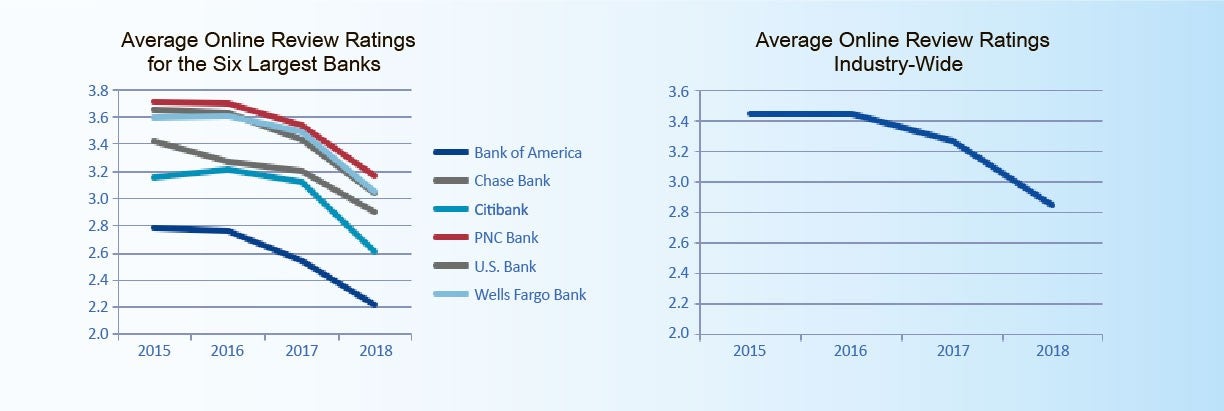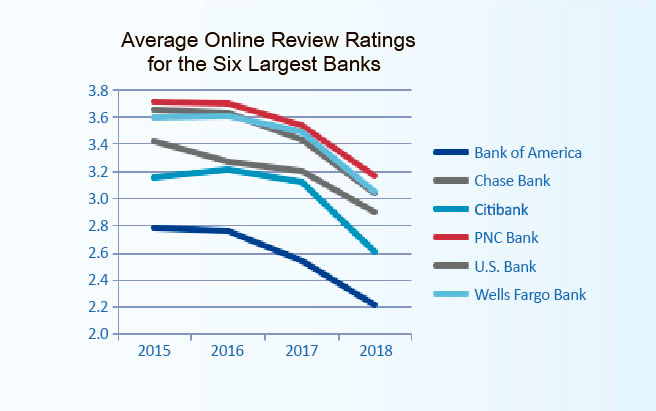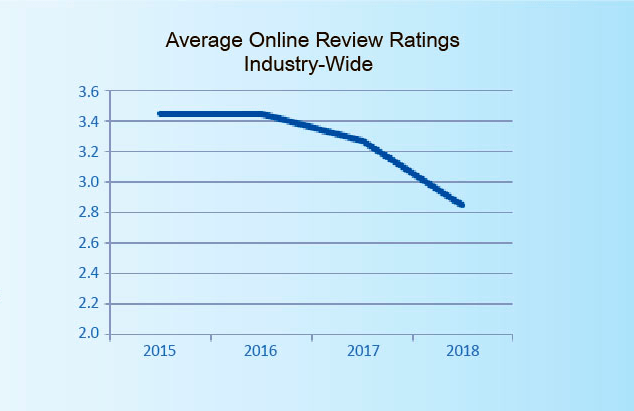2019 Retail Banking Reputation Report
Reputation Staff Writer
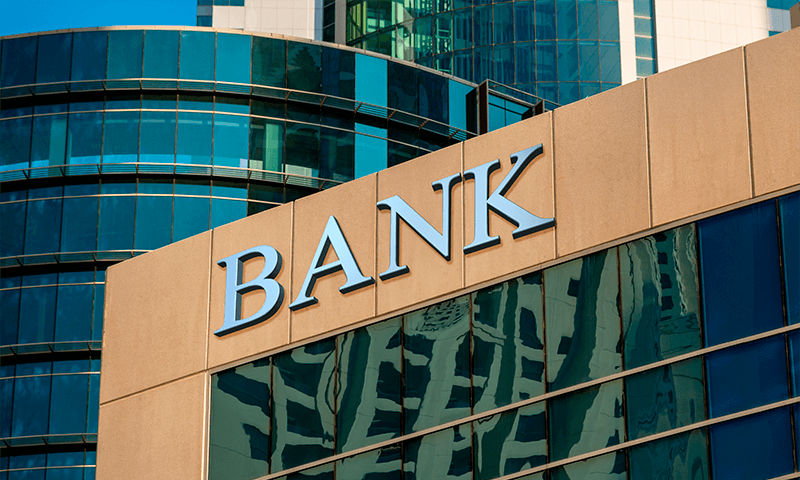
Executive Summary
The Current State of Affairs
Ben Franklin once said, “It takes many good deeds to build a good reputation, and only one bad one to lose it.” Franklin’s quote is apropos to today’s situation with brands and online reviews. Consider this: Eighty-six percent of consumers read reviews of local businesses, and 57 percent won’t use a business with a rating lower than four stars. That’s because 92 percent of consumers trust those conversations, comments and ratings more than they trust advertising. (Bright Local, “Local Consumer Review Survey,” December 2018.)
This creates a challenging environment for banks: Those online reviews that skew negative directly influence banking customers’ choices, as consumers searching for “banks near me” on their smartphone or computer are finding sharp criticisms of banks in their market. In addition, the banking industry has largely been slow to respond to online feedback, especially with Google Reviews. Given these data points and no concrete attempts to address negative feedback, consumers are likely to choose a competing bank with better reviews.
Given the popularity of online banking, you might assume that bad reviews of a bank’s retail locations wouldn’t impact its ability to attract business. But data suggests bank customers prefer in-person interactions. A 2018 survey by Fiserv revealed that 80% of bank customers visited a retail bank site within the past six months, and 52% in the past month. And another study by JD Power found that 58% of bank customers who received banking advice in person felt the service fully met their needs, compared to only 45% who felt their needs were met when they sought advice via digital channels. According to Adweek, 93% of millennials say they rely on blogs and user/consumer reviews before making a purchase. Experience in banks, wait lines, competence of service agents, parking and fees are key dimensions that influence the selection of a local branch for retail banking.
Minding the Gap
To paraphrase the warning on the platforms of the London Underground: “Mind the Gap.” Reputation is distinct from customer experience measures (e.g., NPS) and may be better or worse. When the reputation (as measured by online reviews) of a bank exceeds the underlying reality, the gap poses a substantial risk. Multiple examples of this have existed in the banking industry over the past 10 years, especially in connection with the financial crisis.
In most cases, however, we are seeing that reputation is more negative than reality. While banks have worked hard to address customer experience quality and have made significant progress, disgruntled consumers continue to post negative feedback online, presenting an urgent challenge for banks.
Clearly, no amount of advertising spend is any match for the power of the online consumer voice. But there is a way to positively influence that voice and proactively participate in shaping your bank’s online reputation, and that’s with online reputation management.
92 percent of consumers trust those conversations, comments and ratings more than they trust advertising.
Calls to Action
Banks can influence the mix of online ratings. Statistically, a higher volume of ratings equates to more positive star ratings. There are straightforward ways to increase the volume of ratings.
- Respond to every online review. If you do not respond, it magnifies the damage of a negative review.
- Learn from the online feedback. It’s a gift.
- Master the art of managing online reviews now so that you can play offense rather than defense with your reputation.
The ratings contained in this report have been prepared by Reputation.com, a global leader in reputation measurement and management. Reputation.com’s data scientists are at the center of our reputation analysis, developing the algorithms needed to extract insights from customer feedback and building models to measure the value of those insights. By leveraging the analysis they produce, Reputation.com can work with your teams to address the challenges highlighted in this report.
Why This Report Matters
The 2019 Retail Banking Report gives banks systematic insights into their strengths and opportunities for operational improvement, based on online consumer reviews. This report reveals which banks lead on key dimensions of the banking experience as expressed in the spontaneous, unfiltered voice of the customer in reviews on Google, social media and across the web.
Online data gathered from consumers over the past several years suggests some negative trends are gaining a foothold in the retail banking industry, such as poor customer experience. Thanks to social media, consumer sentiment about these experiences is broadcast far and wide through reviews and star ratings, which have the power to annihilate branch reputations at the speed of a keystroke.
Retail locations in other industries are learning to manage their online reputations, but retail banking locations fall behind in this respect. However, all is not lost. Opportunity exists for retail banks to easily improve ratings online and drive better rankings in search; more website traffic, phone calls, and new accounts; and higher revenue. This rebound depends on how well these banks actively manage their online reputations.
Reputation.com’s 2019 Retail Banking Report can be used by banks to uncover actionable insights that determine online reputation. It will also make the case for investing in reputation management as a key element of a bank’s consumer experience strategy.
Specifically, this report will cover:
- The relationship between online ratings and Reputation Score
- Trends in consumer experience
- Star ratings for 23 banks’ branch locations based on consumer experience
Armed with this information, retail banking locations are better positioned to manage and address their online reputations, analyze consumer feedback to improve operations and processes, and increase consumer engagement.
Scope of Analysis
Reputation.com analyzed online data relating to retail banking locations for 23 major U.S. banks. This data included reviews, listings, social media, search results and customer engagements.
What’s Your Reputation Score?
Measured on a scale of 100 to 1,000, the Reputation Score is a comprehensive index of the digital presence of retail locations in over 70 industries. It is calculated based on factors that include overall review sentiment, volume, recency, spread across review sites, social media sentiment, business listings accuracy and other factors that reflect and impact consumers’ retail banking experiences and opinions, online and on site. Reputation Score is the most comprehensive measure of a retail banking location’s online reputation, as it can be viewed by both customers and potential customers.
Key Findings
Retail Banking Industry’s Reputation Score: Lowest Among Industries
In comparison with retail locations in other industries, the retail banking industry’s average Reputation Score was significantly lower, at 341 (174 points lower as compared with the next-lowest scorer, the retail industry), while automotive dealerships led with a high score of 570. Banks indexed poorly in several key factors of the online Reputation Score, including online sentiment, review volume, recency of reviews, review response rate and number of reviews, as compared with the auto, property and retail industries. These factors have been shown to impact search rankings, web traffic and revenue.
Industry Reputation Score Comparison

Let’s take a look at three of the main elements influencing Reputation Score.
Ratings Drop, Review Volume Is Low — and No One Is Responding Online to Customer Concerns
Star ratings are only one element influencing Reputation Score, but they feature prominently on search results and are therefore a key factor in driving consumer choices. It’s worth noting that the average star ratings for retail banks have dropped significantly since 2015 among some of the most well-known banking brands. For example, in 2015, PNC Bank clocked in with an average rating of 3.7; by 2018, that rating dropped to just below 3.2. Bank of America was at 2.8 in 2015 and dropped to 2.2 by 2018. (Interestingly, no bank surpassed a rating of 3.7 in any category in 2018.)
Also contributing to the Reputation Score is review volume. According to our analysis, all 23 banks sustained a low review volume throughout the four-year analysis period. Bank of America logged only 17.3 reviews per location in that time frame — the highest on the list. This is significant because the more reviews a bank has, the higher it ranks in search results. Higher rankings contribute not just to a higher Reputation Score, but also to a greater likelihood of being selected by the consumer.
Most of the retail banks in our survey also logged low response rates to key concerns from customers expressed online. Over four years, one of the best responders was KeyBank, which made the most effort to respond to 79 percent of online reviews. U.S. Bank followed that up by responding to 71 percent. Conversely, many banks had a 0-percent response rate. As has been shown in other industries, customer engagement drives loyalty, and much of that customer engagement can take place online, by responding to customer concerns and showing commitment to addressing them quickly.
Reputation Scores of 23 Retail Banks in the United States
The table below lists the 23 retail banks surveyed for this report by Reputation Score, from highest to lowest.
About the Reputation Score
The Reputation Score is comprised of nine elements:
- Star average
- Review volume
- Review recency
- Review spread
- Search impression
- Review response
- Listing accuracy
- Social impression
- Review length
The Reputation Score is a function of these nine elements. Each has internal factors, which are calibrated independently (e.g. more recent and prominent reviews have a greater impact on the star average thermometer than older reviews buried on less prominent sites.) Once each of these factors is calibrated, the overall Reputation Score is calculated. These impacts are updated twice a year.
It’s important to note that the Reputation Score is not consumer-facing. Rather, it’s a tool by which banks can:
- Measure their own progress in addressing consumer sentiment on a monthly, quarterly and annual basis
- Determine how they compare to their peers in the industry
- Discover how the banking industry compares with other industries
- Compare branches
The scores reflect all online feedback, which can date back several years, and data about the banks and their retail locations. Capital One led the pack with a Reputation Score of 405, which is 64 points higher than the industry average for retail banking but still low as compared with other major industries.
“The best way to fully understand on-site customer experience is to apply AI, natural language processing and machine learning to the vast cloud of unprompted, unstructured data on the social web.”
Dr. Brad Null, Chief Scientist, Reputation.com
Customer Sentiment Ratings by Category
An increase in searches for “banks near me” indicates that, while consumers may be embracing online banking, visits to local branches continue. To understand customer experiences in these visits, we built machine learning models to explore all of the online feedback about retail banks and categorize it. The map below shows both the relative frequency of major topics in online feedback for a typical bank, as well as the average sentiment around these topics.
As you can see here, some of the key categories include General Staff, Courtesy, Wait Time/Efficiency, Parking/ Facilities and Competence. Here, we break down average star ratings of reviews where these categories were mentioned.
General Staff
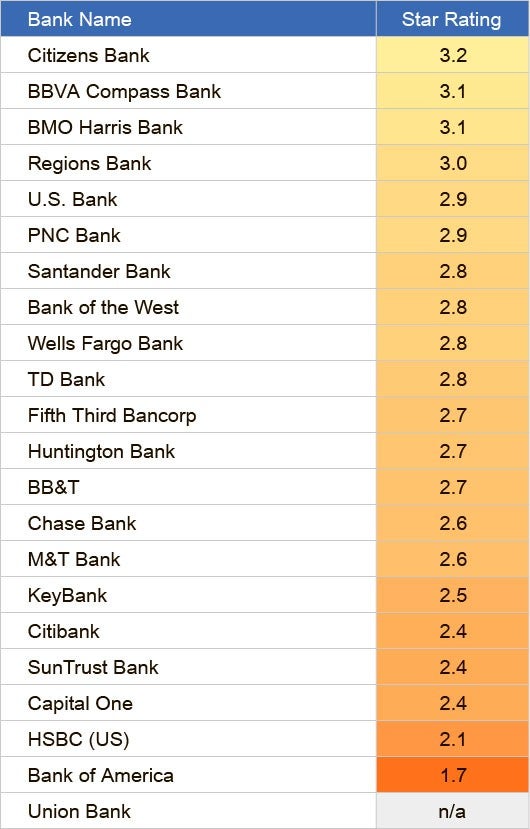
*n/a = not enough data to calculate a star rating
Ratings in this category are generally low — none of the 23 banks rate higher than 3.2 (Citizens Bank) out of 5 stars, indicating an opportunity for improvement as banks review their Reputation Scores.
Courtesy
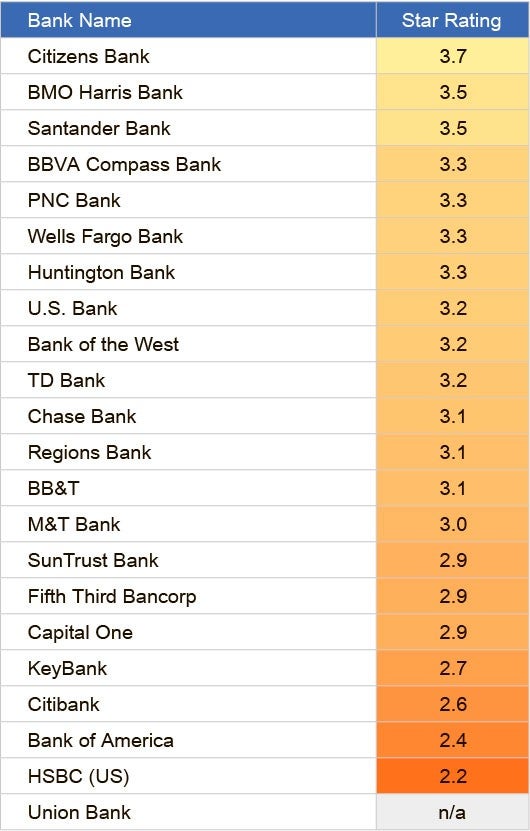
*n/a = not enough data to calculate a star rating
Courtesy emerges as another area of opportunity for banks to improve. Citizens Bank again leads the pack, with a 3.7 rating — among the highest in all categories — for Courtesy. Other standouts in this category are BMO Harris Bank and Santander Bank, each with a rating of 3.5.
Wait Time/Efficiency
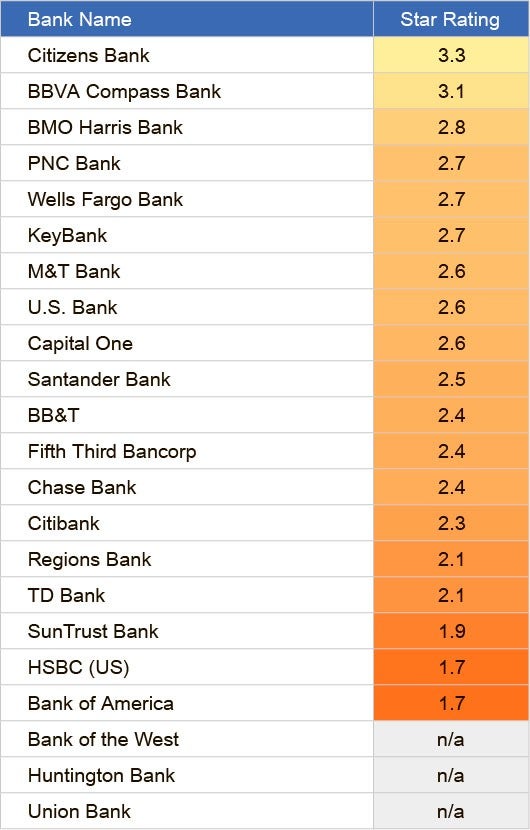
*n/a = not enough data to calculate a star rating
Long lines seem to be an Achilles’ heel at the branches in our sample. In Wait Time/Efficiency, Citizens Bank holds the lead again with a ranking of 3.3. Only BBVA Compass Bank comes close with a 3.1 ranking. Most of the others score in the two-star range.
Parking/Facilities
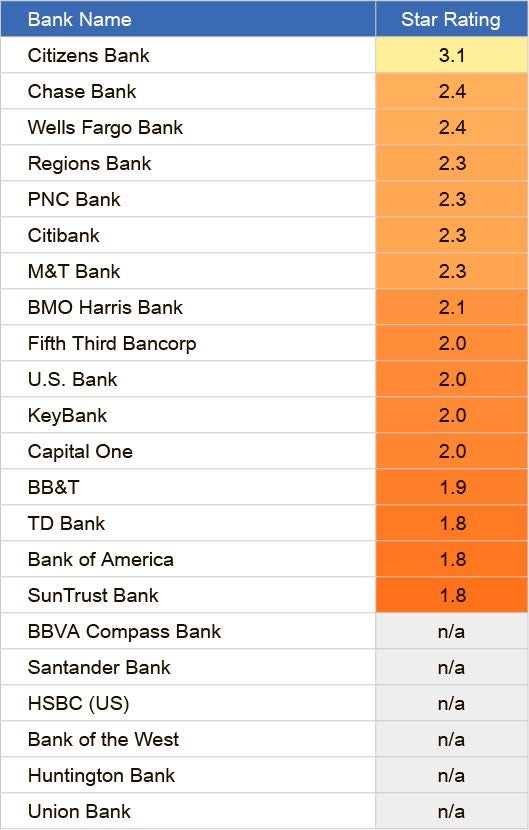
*n/a = not enough data to calculate a star rating
Parking might not immediately leap to one’s consciousness when debating which bank to patronize, but plenty of reviewers take issue with it in our analysis. Aside from Citizens Bank’s ranking of 3.1, all others fall well below. This should prompt banks’ review of their facilities and how they can better accommodate their customers. After all, customers can’t come in if they can’t find a parking spot.
Competence
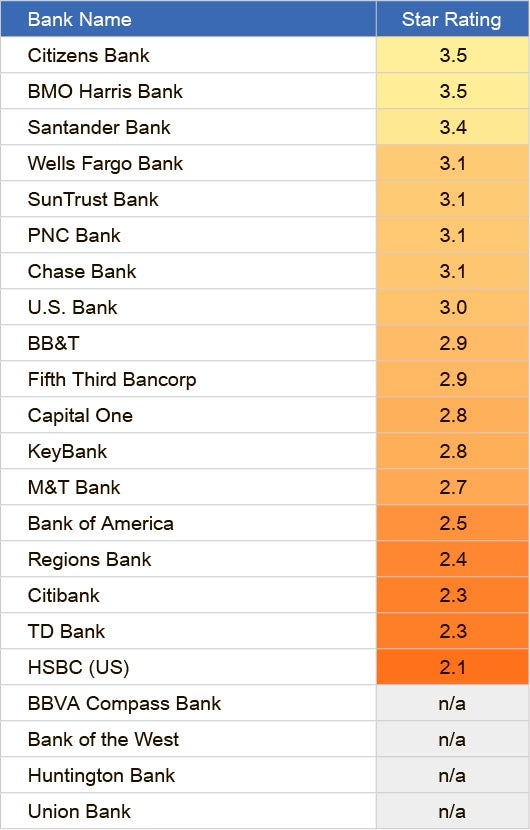
*n/a = not enough data to calculate a star rating
Understandably, bank customers want the most qualified people handling their hard-earned money. But low allaround ratings in this category suggest dissatisfaction with the level of competence of bank personnel. While Citizens Bank (3.5), BMO Harris Bank (3.5) and Santander Bank (3.4) reel in the highest ratings, the others on the list again clock in with ratings in the two-star range.
Conclusion
As is evident from the findings in this report, online sentiment is a window into where organizations excel and where issues exist. In the case of retail banking, there’s tremendous room for improvement, as well as a tremendous opportunity to improve ratings online and drive better rankings in search; more website traffic, phone calls and new accounts — all resulting in higher revenue.
By managing their online presence, retail banks have visibility into operational shortcomings, that, when addressed quickly and adequately, translate to satisfied, loyal customers that return again and again for new products and services.
Reputation.com provides both a strategy and a comprehensive program to significantly improve search, resulting in increased revenue for your bank. Following are just a few of the results you can expect:
- Significant increases in review volume (more reviews = higher ratings)
- More current reviews
- The ability to simply and easily respond to a higher percentage of reviews
- Immediately address areas of consumer concern
Reputation.com is pleased to offer your team a complimentary diagnostic review of your bank’s Reputation Score and share a deep-dive review of the nine components that comprise your bank’s score. To arrange a private diagnostic review and learn how Reputation.com can help you make immediate improvements, please call Tom Barnes, Managing Director of Financial Services, at (973) 600-4008.
About Reputation.com
Reputation.com, Inc., based in Silicon Valley, pioneered online reputation management (ORM) technology for the enterprise market in 2006. With its SaaS platform, Reputation.com technology has managed tens of millions of consumer reviews and consumer interactions across hundreds of thousands of online points of presence for global companies spanning 77 industry verticals. Most recently, Reputation.com was ranked ranked No. 1 in Enterprise Online Reputation Management in G2 Crowd’s spring 2019 report. The ranking is based on G2 Crowd’s proprietary algorithm that calculates global rankings based on overall customer satisfaction, ease of doing business with, market presence, likelihood to be recommended and number of reviews.

